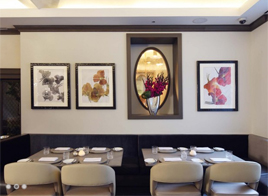The East Pole
 Monday, December 2, 2013 at 09:29PM
Monday, December 2, 2013 at 09:29PM  When’s the last time a cloned restaurant was actually better the second time? Usually, the clone is a poor shadow of the original. Occasionally they’re equal, if the management is really good.
When’s the last time a cloned restaurant was actually better the second time? Usually, the clone is a poor shadow of the original. Occasionally they’re equal, if the management is really good.
The East Pole breaks the rules. Billed as an uptown version of The Fat Radish, it’s a significant improvement on its predecessor. Not that the Fat Radish was that bad, but when we visited, the food wasn’t impressive enough to overcome poor service and a room so loud it was headache-inducing. Perhaps it has improved; I wasn’t inclined to go back.
The concept is cleverly re-imagined for the Upper East Side ecosystem. The room has a bright sheen, casual but refined, with edison bulbs, blonde wood tables, plush black leather banquettes, and soft music in the background. You can be comfortable here, and don’t have to shout to be heard.
Like the Fat Radish, the restaurant wears its farm-to-table ethos on its sleeve, with a list of purveyors on the back of the menu, and servers in brown aprons as if they’d just walked in from the barn. Our server delivered a sermon on pickling, which he does in his spare time at home. After a while, it felt like too much information. The menu is vaguely British (Scotch Egg, Fish Pie), to an extent you’d barely notice. Although reprinted daily, there’s a sizable list of recited specials with quite intricate descriptions: why?
Prices at the East Pole are a bit higher than at the Fat Radish. A Piedmontese Flank Steak at the Radish ($28) becomes a Piedmontese New York Strip uptown ($42). What seems (from the description) to be the same Heritage pork chop is $28 downtown, $32 uptown. But the bacon cheeseburger is $19 in both places. The room is so much nicer that I’d gladly pay a few bucks more.




























